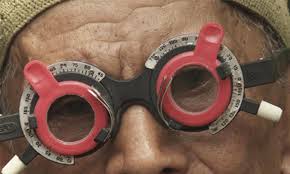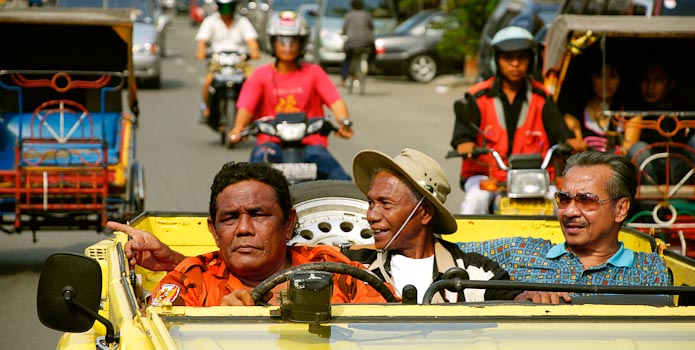
In the powerful and chilling The Look of Silence, documentarian Joshua Oppenheimer explores the aftermath of genocide in a society that has never experienced a truth and reconciliation process. This is Oppenheimer’s second masterpiece on the Indonesian genocide of 1965-66 in which regime-sponsored death squads executed over one million suspected political opponents. Today, the victims’ families live among the murderers.
The Look of Silence centers on 44-year-old optometrist Adi, as he investigates the murder of Ramli, the older brother he never knew. Earlier, Oppenheimer had filmed Ramli’s killers as they describe and act out Ramli’s savage torture, mutilation and murder. They are unrepentant and even nostalgic about their crimes. Their matter-of-fact recollections are sickening. We see Adi watching this video, trying to contain his rage and disgust. Later, Adi – in the guise of fitting them for new glasses – is able to confront those responsible. He faces the actual machete-wielding killers, the leader of the village death squad, the higher-up who ordered the killings and even one of his own relatives.
What makes this bearable to watch (and even more affecting) is meeting Adi’s family: his earthy 80-something mother, his frail and batty 103-year-old father, his giggly 7-year old daughter and his 10-year-old son. There’s plenty of humor in this warm family. But in one scene, the son receives a ridiculously twisted propaganda version of the genocide in public school.
The “Silence” in The Look of Silence is reinforced by the spare soundtrack. We often hear only “crickets” (frogs, actually).
The Look of Silence is the companion to Oppenheimer’s The Act of Killing, which made my list of Best Movies of 2013. In The Act of Killing, Oppenheimer got the unapologetic killers to re-enact their atrocities for the camera – even relishing their deeds. The Act of Killing contains some of the most bizarre moments in any documentary EVER, including a cross-dressing mass murderer and a staged Bollywood-like musical number of Born Free, complete with dancing-girls in front of a waterfall, in which the garotted dead reappear to thank the killers for sending them on to the afterlife. The Act of Killing is more of a jaw-dropper. The Look of Silence – because it is more personal, is more powerful.
The Look of Silence stands alone – you can fully appreciate it without having seen The Act of Killing. But what I wrote about The Act of Killing is true for both films: “hypnotically compelling – you can’t believe what’s on the screen, can’t believe that you’re still watching it and can’t stop watching”.
I saw The Look of Silence at the San Francisco International Film Festival before its limited theatrical release slated for July 17. It’s one of the best films of 2015.

